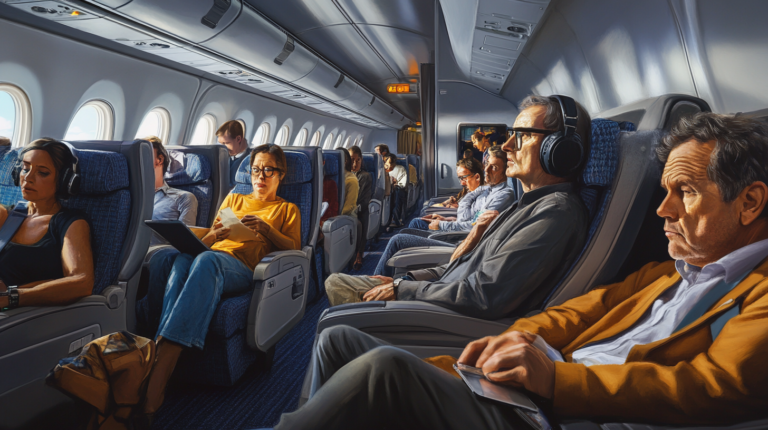Airline Food: The Best and Worst Meals in the Sky
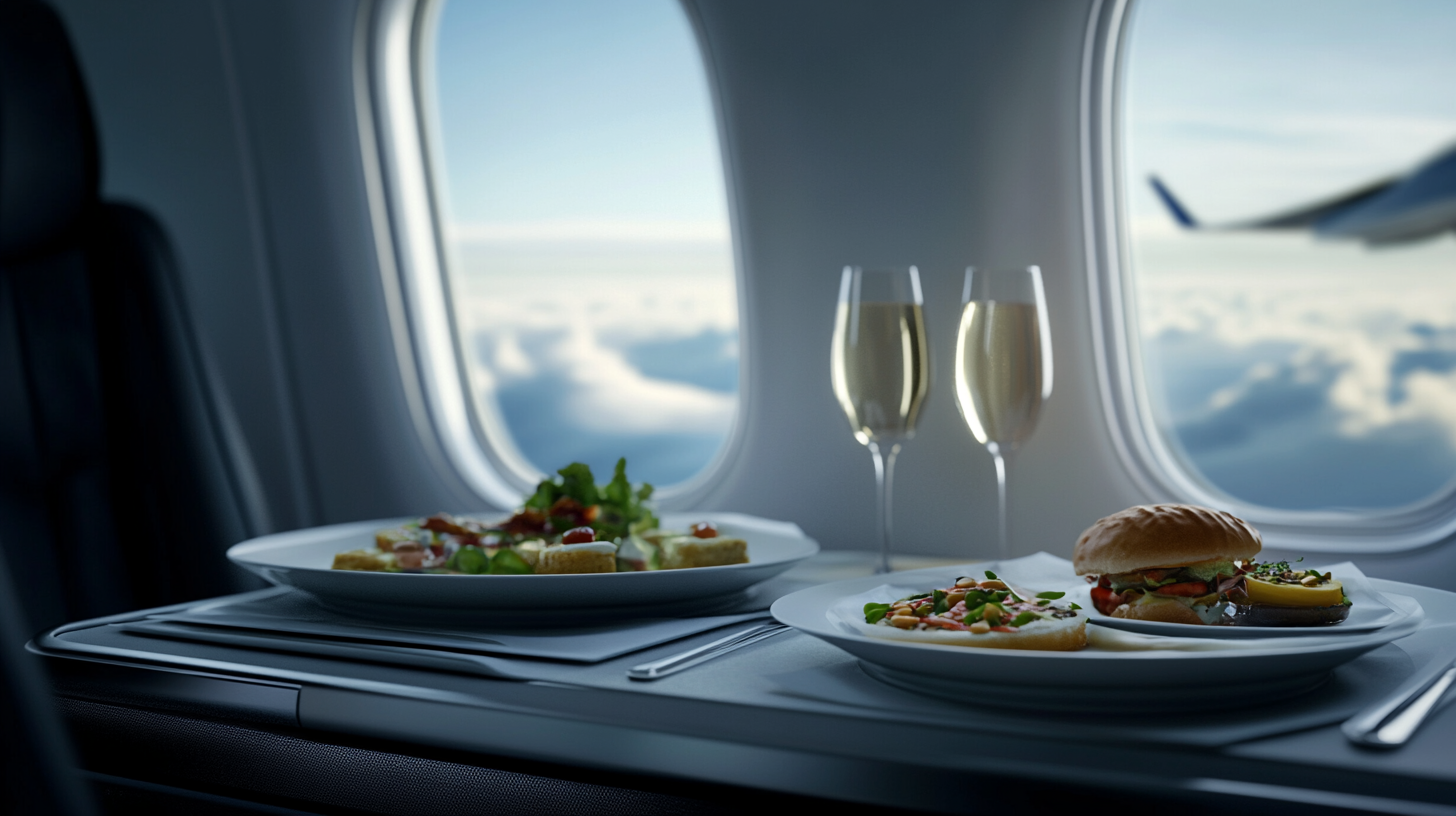
Air travel has transformed from a mere mode of transportation into an experience that encompasses comfort, entertainment, and gastronomy. Amidst the advancements in technology and in-flight entertainment systems, one aspect that continues to spark vivid discussions among passengers is in-flight dining. Whether it’s relishing a gourmet meal crafted by a world-renowned chef or grappling with a lackluster dish that leaves taste buds underwhelmed, the food served at 35,000 feet plays a pivotal role in shaping the overall journey. Stories of exceptional culinary delights and disappointing dining experiences are frequently shared across social media platforms, influencing perceptions and expectations. This comprehensive exploration delves into recent reviews and ratings of airline meals, uncovers the challenges of serving food at altitude, and highlights the innovative approaches airlines are adopting to transform in-flight dining into a memorable part of the travel experience, as discussed in The Evolution of Airline Culinary Services in Modern Travel .
The Importance of In-Flight Dining
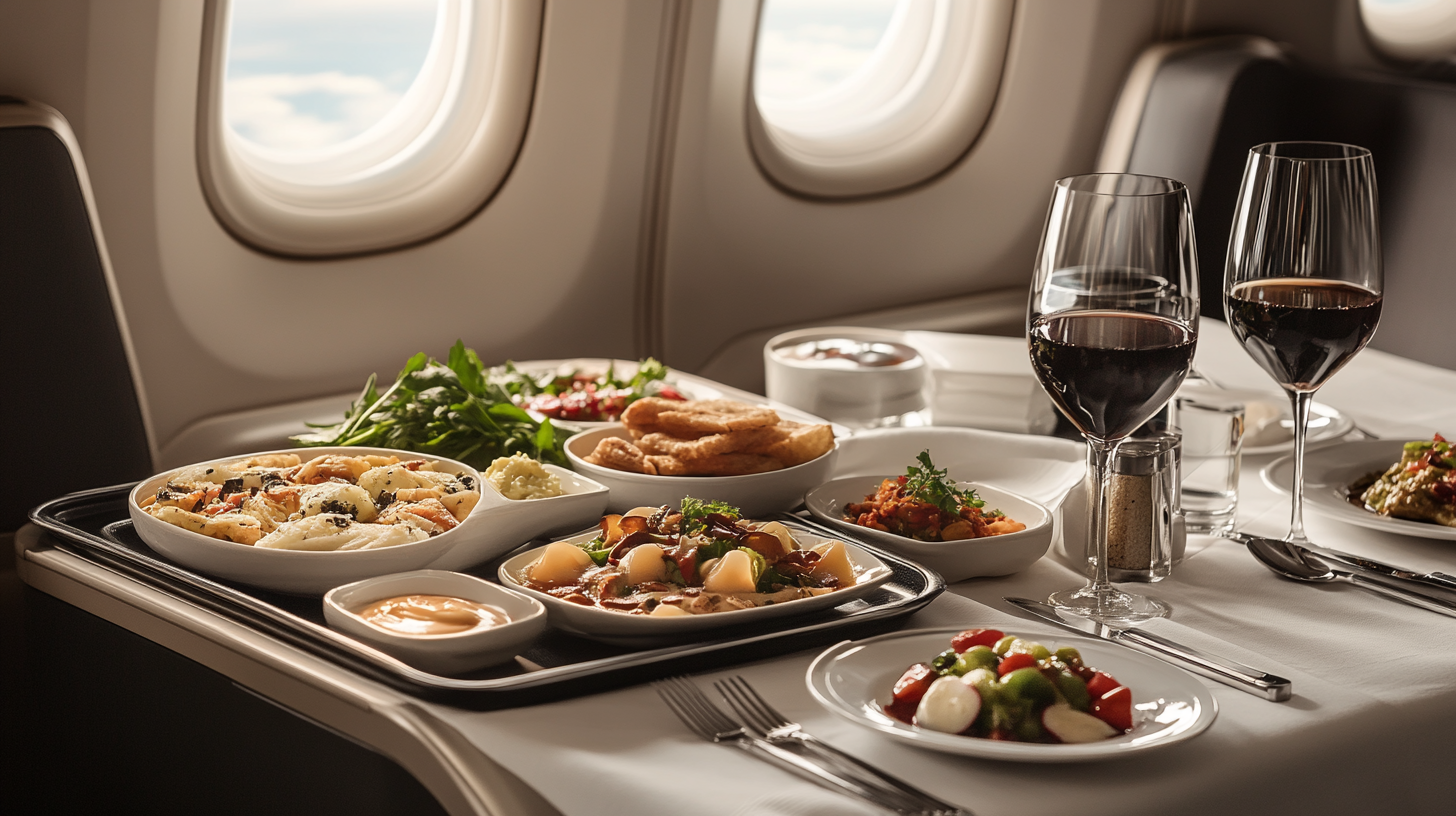
In-flight dining transcends the basic need to satiate hunger during a flight; it’s an integral component of the passenger experience that can enhance satisfaction and foster loyalty. Airlines recognize that exceptional meals can significantly influence a traveler’s choice of carrier, with over 60% of passengers prioritizing meal quality when selecting an airline. The impact of these experiences is amplified in today’s digital age, where passengers readily share their culinary journeys on social media. A positive review or a tantalizing photo can bolster an airline’s reputation, while negative feedback can deter potential customers. This phenomenon underscores the importance of investing in quality in-flight dining, as highlighted in How In-Flight Meals Influence Airline Brand Perception . By delivering meals that delight the senses, airlines can create lasting impressions that extend beyond the duration of the flight.
Challenges of Culinary Service at Altitude
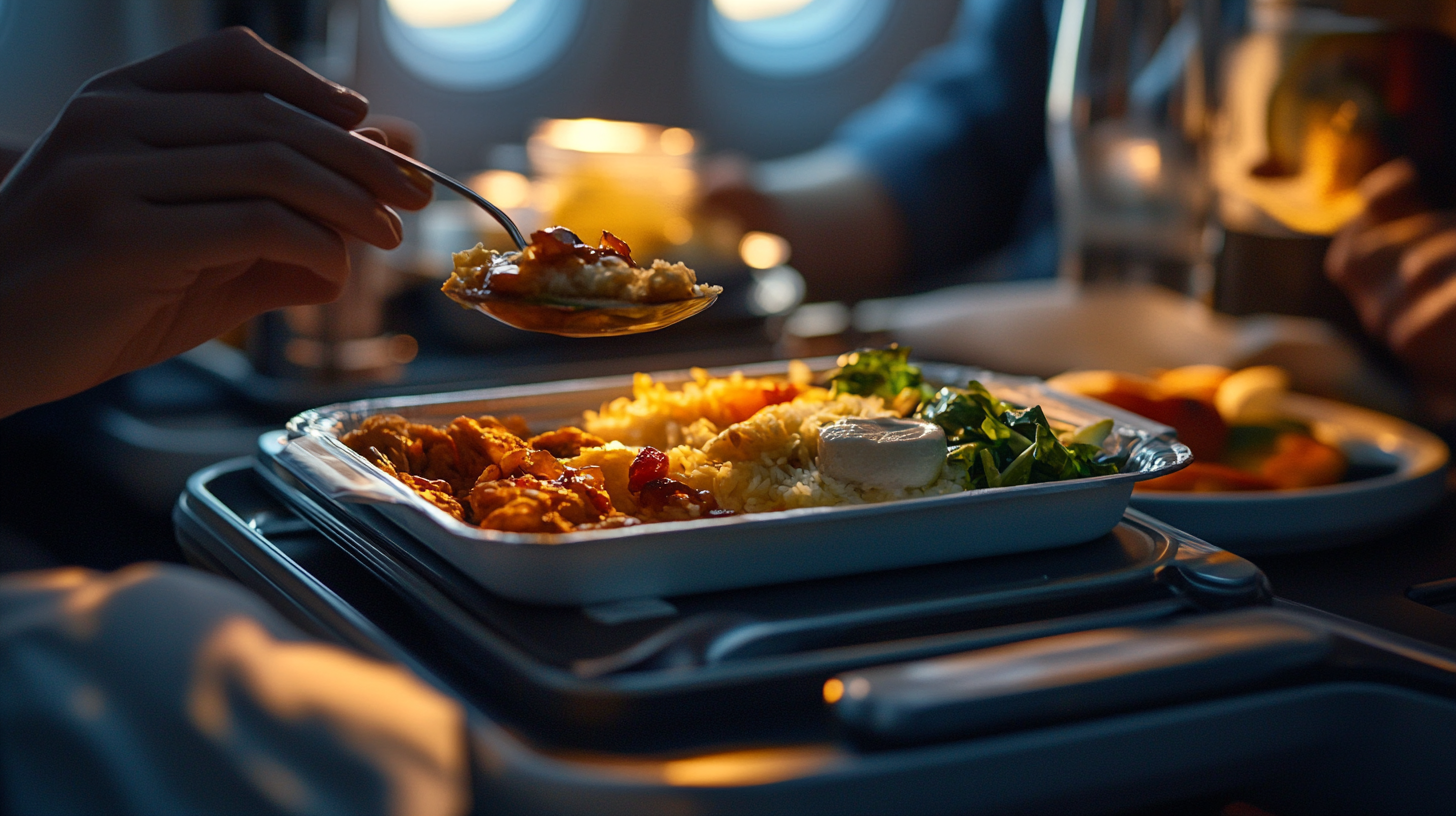
Serving delectable food at cruising altitude presents a unique set of challenges rooted in the cabin environment. The combination of low humidity and reduced air pressure dulls passengers’ taste receptors, decreasing taste sensitivity by approximately 30%. The cabin atmosphere affects the perception of sweet and salty flavors the most, necessitating adjustments in seasoning and recipe formulation. Additionally, the constant noise and vibrations within the aircraft can further impair taste and smell, essential senses for flavor detection. The logistics of in-flight meal preparation add another layer of complexity. Meals are pre-cooked and then reheated on board due to safety regulations and limited kitchen facilities, which can compromise the texture and freshness of the food. Space constraints in the galley limit the variety and complexity of dishes that can be served. Airlines often address these obstacles by enhancing recipes with umami-rich ingredients and robust flavors to compensate for the diminished taste perception at altitude, a strategy explored in The Science of Taste and Airline Food Preparation .
Innovative Approaches to In-Flight Dining
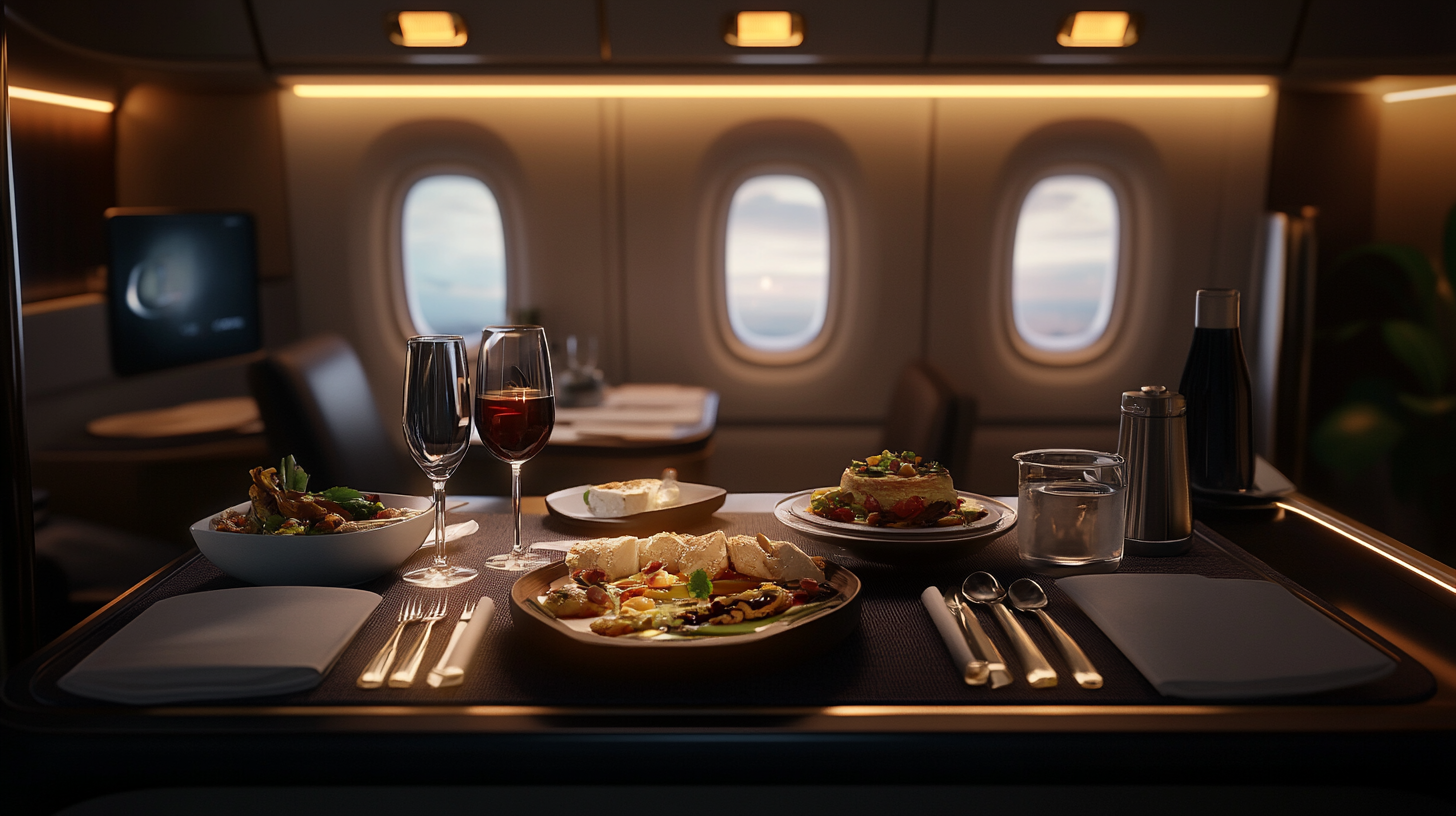
To surmount the challenges of altitude and satisfy discerning palates, airlines are embracing innovation and creativity in their culinary offerings. Collaborations with celebrity chefs and culinary institutes bring expertise and sophistication to in-flight menus. By emphasizing fresh, locally sourced ingredients, airlines offer meals that reflect regional cuisines and cultural diversity, transforming flights into immersive epicurean adventures. Airlines are also leveraging technology to personalize dining experiences. Passengers can pre-select meals or customize options to cater to dietary restrictions and preferences, enhancing satisfaction and comfort during their journey. Some carriers are experimenting with meal kits that passengers can assemble themselves, adding an interactive element to in-flight dining. These initiatives demonstrate a commitment to elevating the quality and enjoyment of airline meals, aligning with contemporary trends in hospitality, as detailed in Innovative Culinary Trends in the Aviation Industry .
Airlines Leading the Way in In-Flight Dining
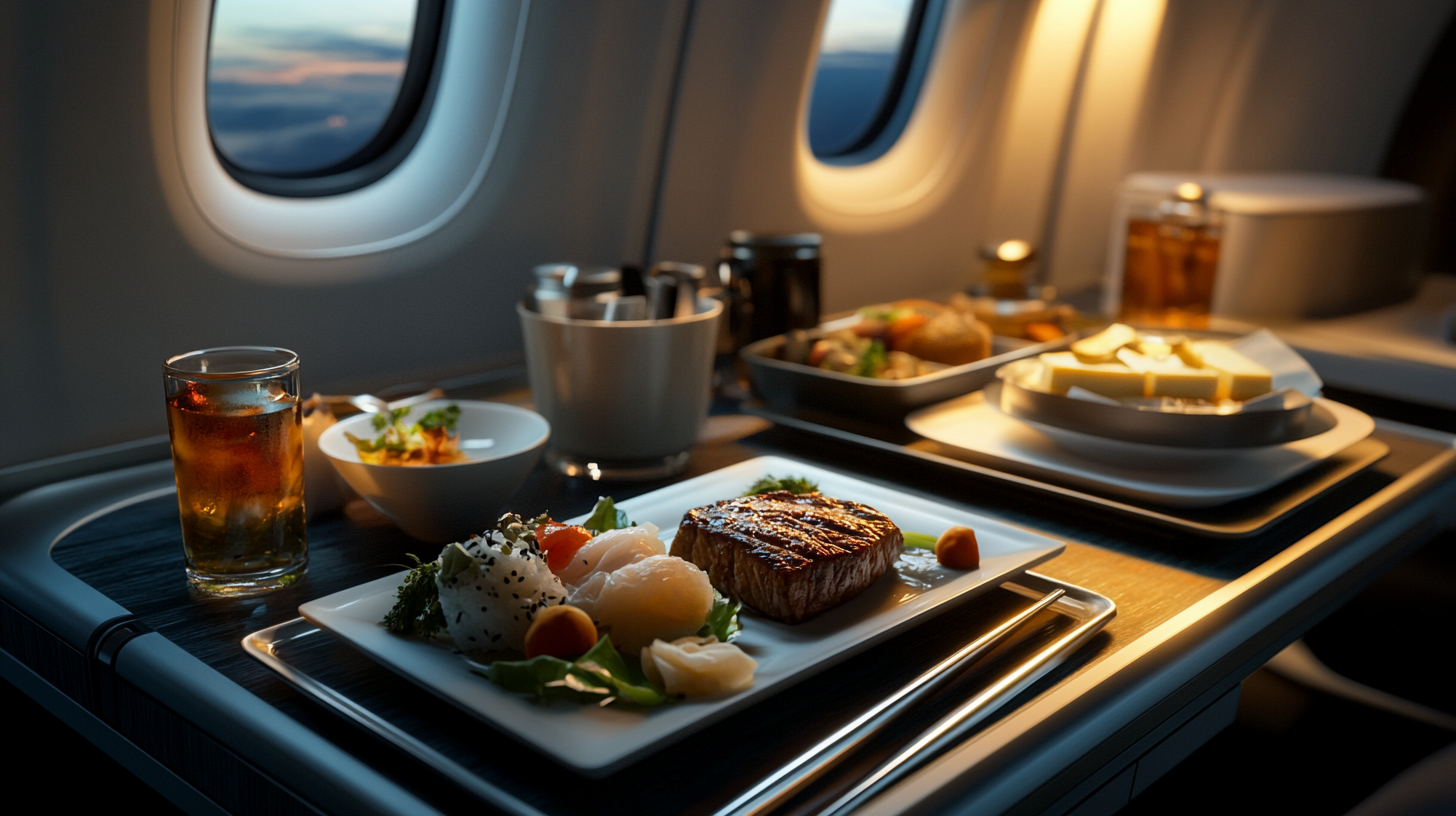
Emirates
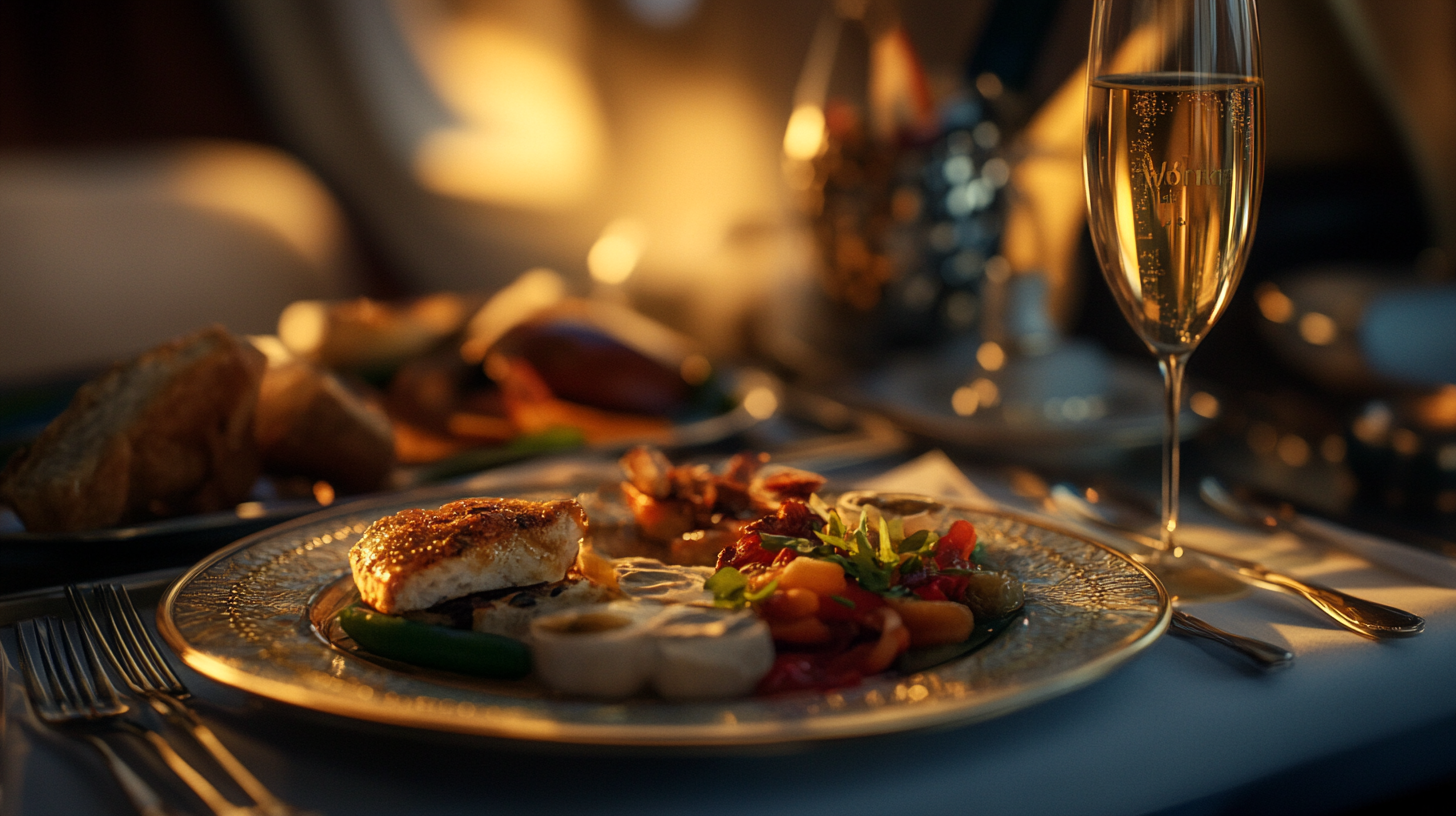
Emirates continues to set the benchmark for luxurious in-flight dining experiences. Passengers across all classes are treated to gourmet meals that reflect a fusion of international flavors. The airline’s menus are thoughtfully crafted to cater to diverse palates, offering dishes like grilled chicken with saffron-infused rice or lamb brochettes with oriental seasonings. In first class, the dining experience is akin to a five-star restaurant. Passengers can indulge in an extensive menu featuring delicacies such as caviar with traditional garnishes, lobster thermidor, and an array of fine cheeses and desserts. The beverage selection is equally impressive, with exclusive wines and spirits available. Emirates’ dedication to culinary excellence ensures that passengers feel pampered throughout their journey, exemplifying the pinnacle of in-flight luxury as showcased in Emirates’ Signature First-Class Dining Experience .
Singapore Airlines
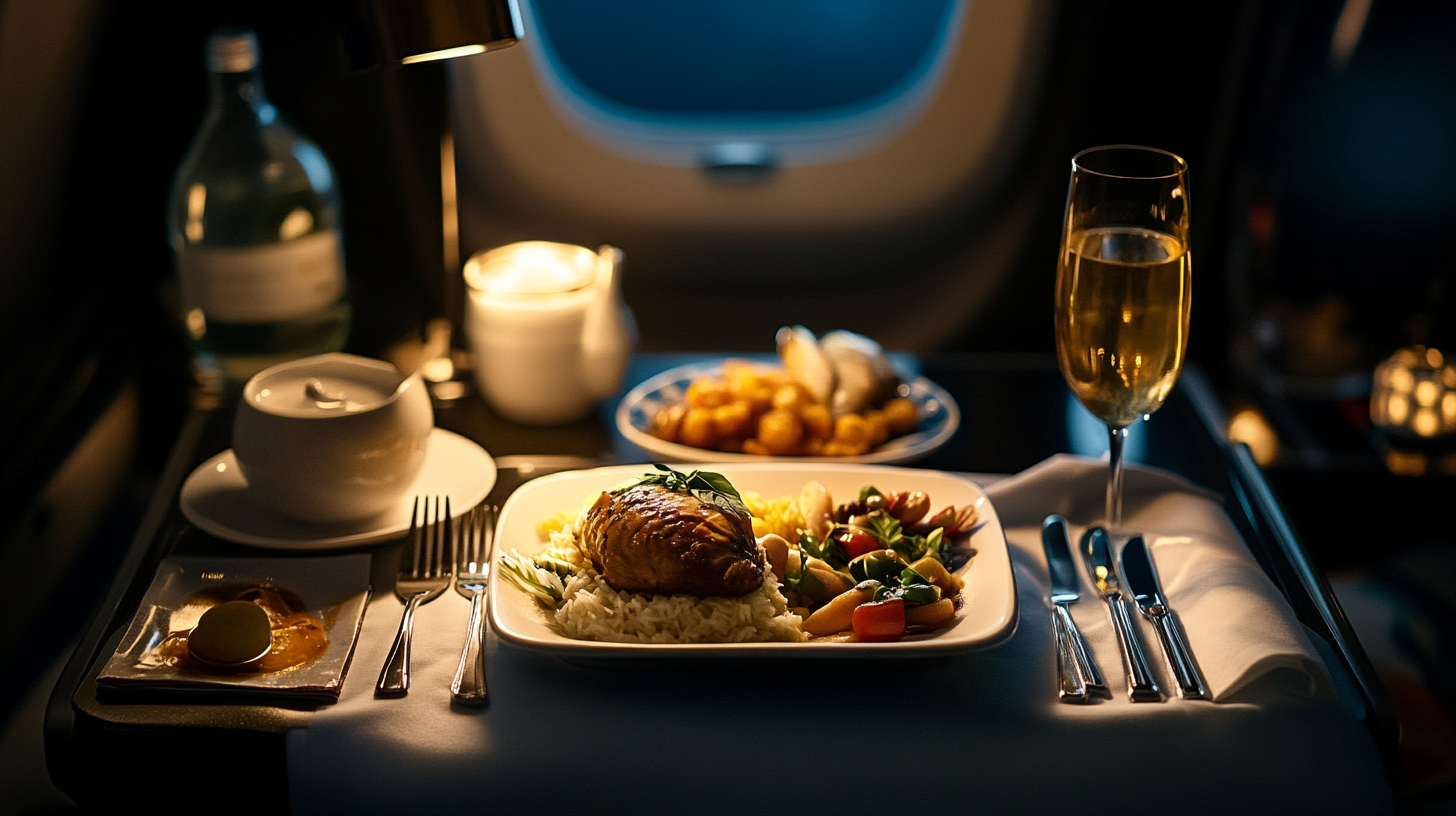
Singapore Airlines is renowned for its “Book the Cook” service, which epitomizes personalized in-flight dining. Passengers in premium classes can pre-order from an extensive menu featuring gourmet dishes crafted by a panel of international culinary experts. Selections include succulent lobster thermidor, fragrant Singapore-style chicken rice, and tender beef fillets, allowing travelers to enjoy restaurant-quality meals tailored to their tastes. Even in economy class, the airline maintains high standards of quality and variety. Passengers praise the flavorful meals and appreciate options that cater to dietary preferences, including a wide range of vegetarian and special diet accommodations. Singapore Airlines’ commitment to exceptional dining experiences enhances its reputation for excellence and innovation, as detailed in Singapore Airlines’ Culinary Collaboration with World-Class Chefs .
Air France
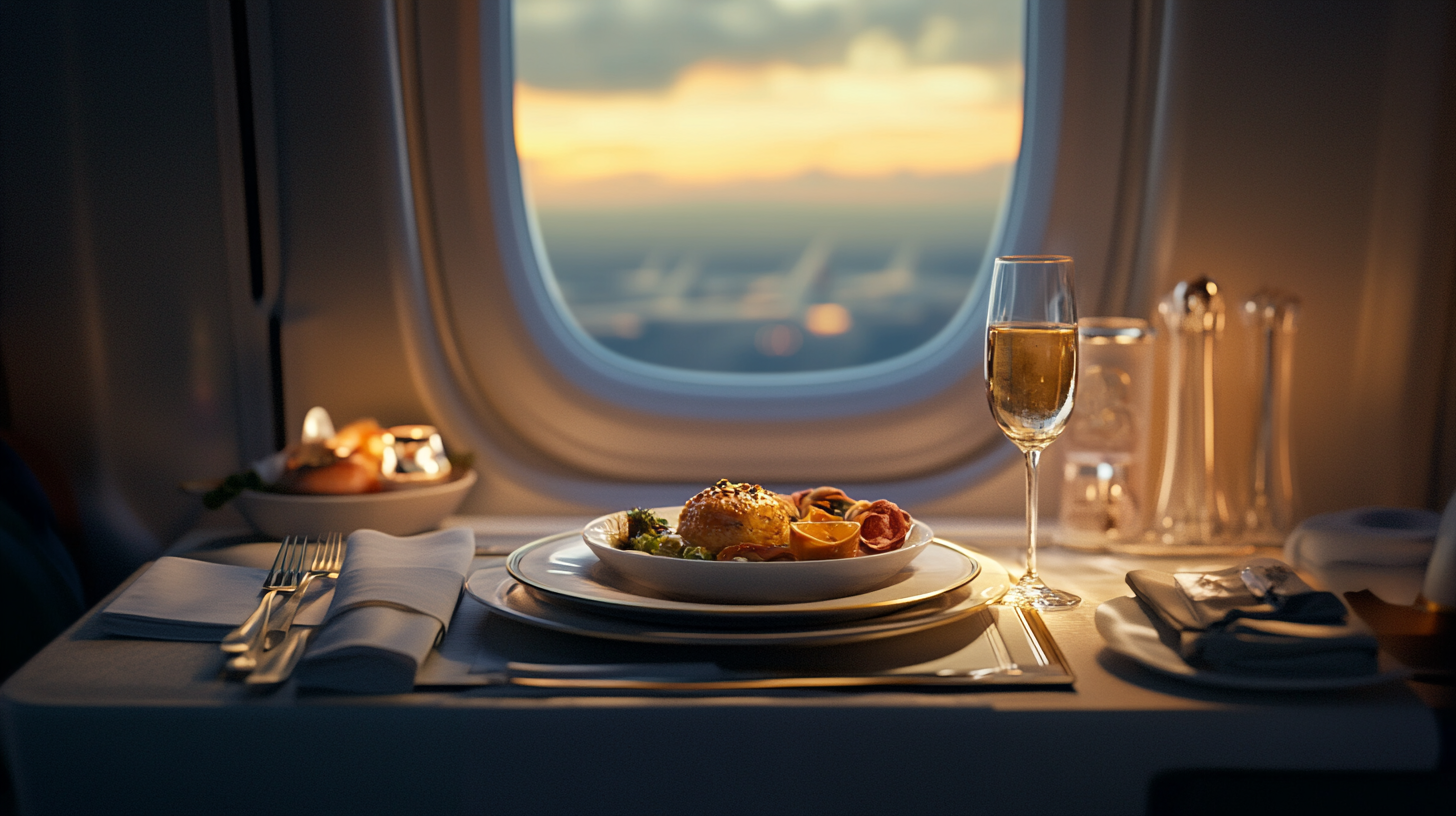
Air France elevates in-flight dining by infusing French culinary artistry into its services. Its “La Première” first-class offering presents elite gastronomic experiences featuring dishes such as langoustines with caviar and foie gras accompanied by a selection of fine wines and champagnes. The airline collaborates with Michelin-starred chefs to curate menus that reflect the richness of French cuisine. On a recent economy flight from Paris to Singapore, passengers were delighted by the “pimp your meal” concept by Maison Lenôtre, which allowed them to enhance their dining experience with premium offerings like salmon panna cotta and Viennese chicken. This innovative approach underscores Air France’s dedication to providing gourmet experiences regardless of class, embodying the essence of French hospitality as explored in The Art of French Cuisine at 35,000 Feet .
Turkish Airlines
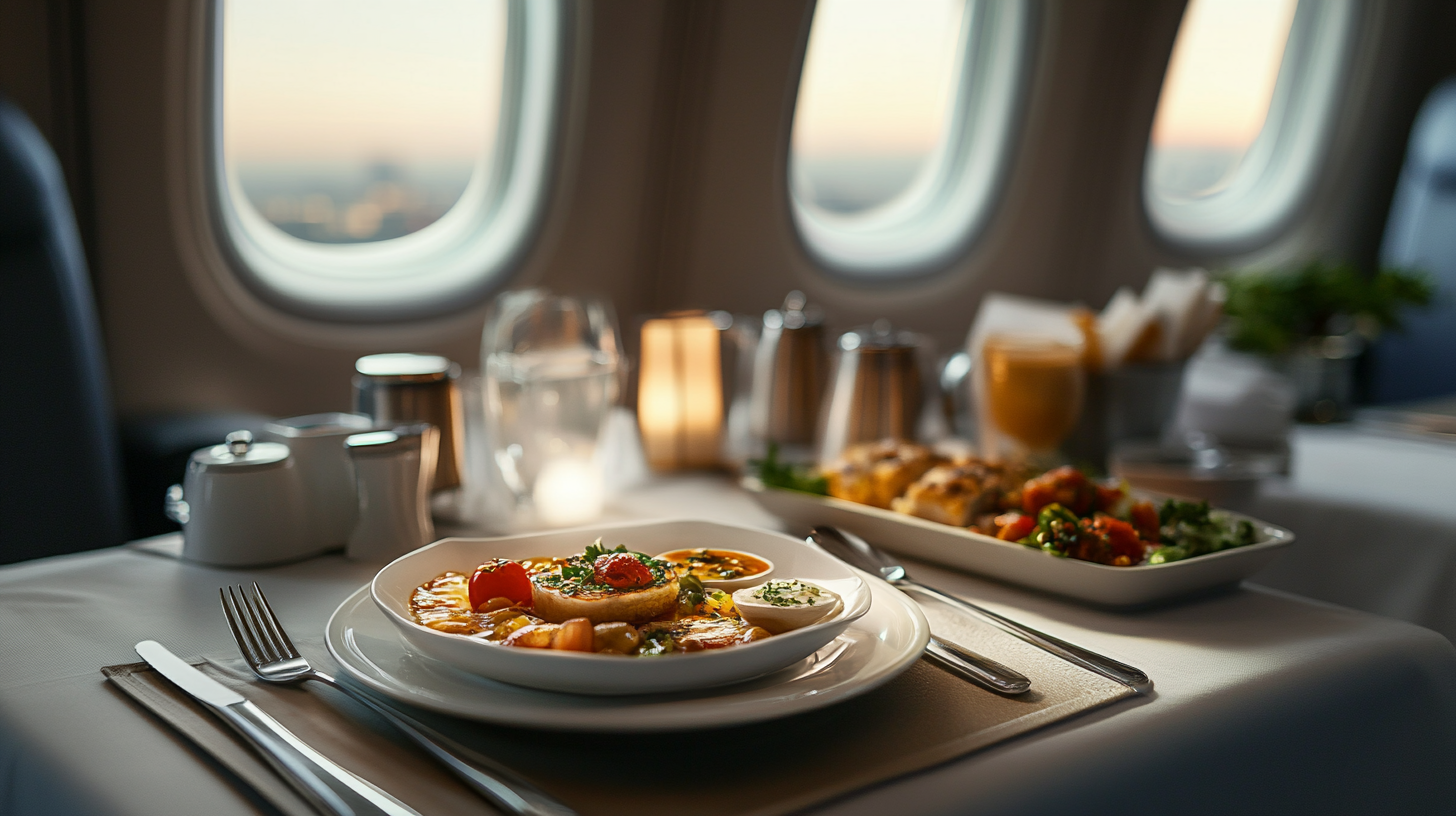
Turkish Airlines excels in offering passengers a taste of the Mediterranean with its flavorful and authentic cuisine. The airline partners with top chefs to create menus that highlight fresh ingredients and traditional recipes, such as succulent kebabs, stuffed vine leaves, and rich baklava for dessert. These dishes are designed to retain their flavor and appeal even after reheating, addressing the challenges of in-flight food preparation. Turkish Airlines’ focus on regional specialties allows passengers to begin immersing themselves in the culture of their destination from the moment they step aboard. This commitment to culinary authenticity enhances the overall travel experience, as highlighted in Turkish Airlines’ Culinary Journey Through Mediterranean Flavors .
JetBlue
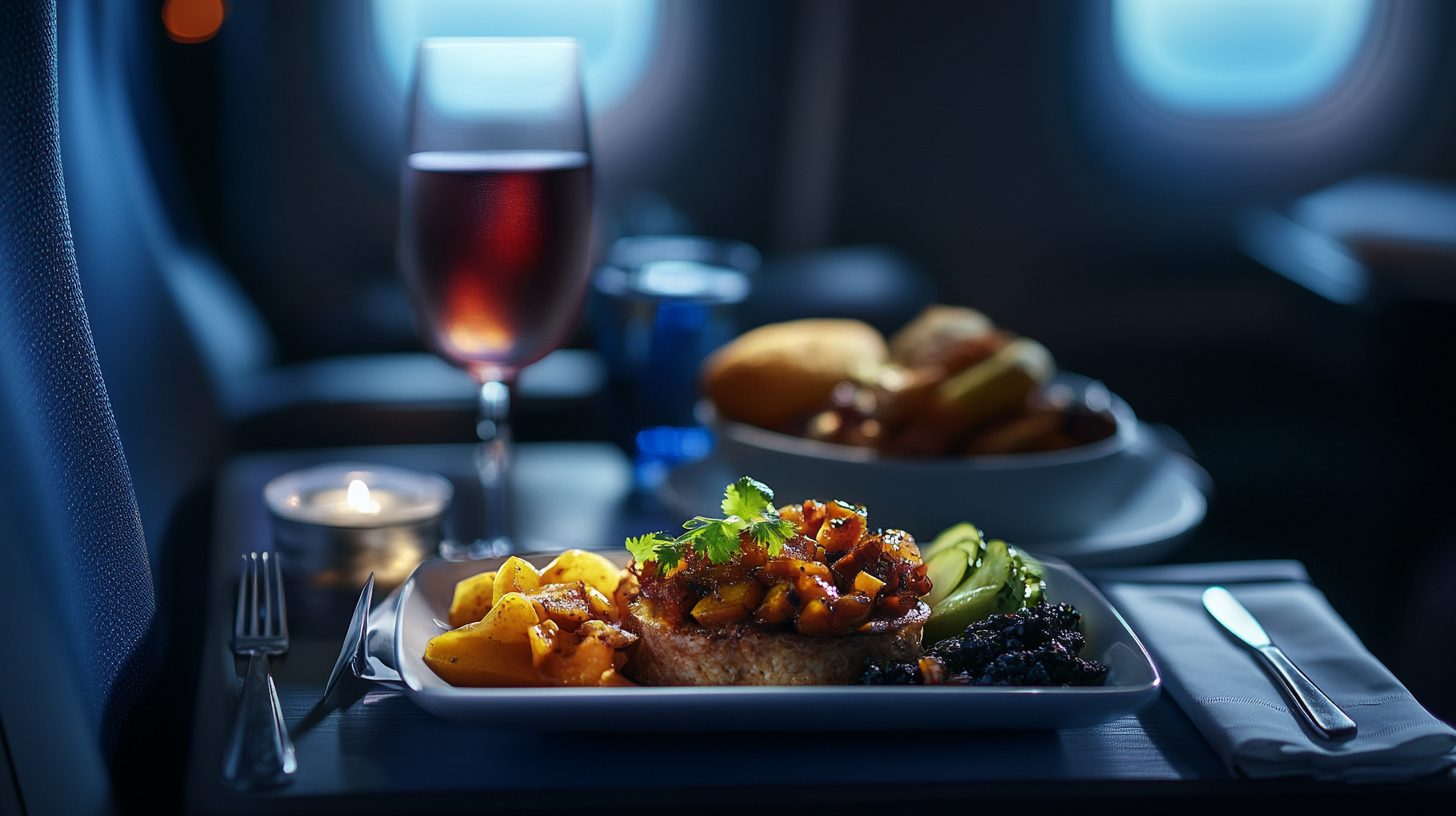
JetBlue has redefined in-flight dining for transatlantic flights through its partnership with the farm-to-table eatery DIG. This collaboration brings fresh, high-quality meals to passengers, even in economy class. Travelers appreciate the airline’s commitment to serving dishes made with seasonal ingredients sourced from local farms. Meals such as grilled chicken with roasted vegetables or hearty grain bowls offer a nutritious and satisfying alternative to traditional airline fare. JetBlue’s innovative approach reflects a growing trend toward healthier, more sustainable in-flight dining options, resonating with passengers’ evolving preferences and contributing to a positive travel experience, as discussed in Sustainability and Freshness in JetBlue’s In-Flight Dining .
Kuwait Airways
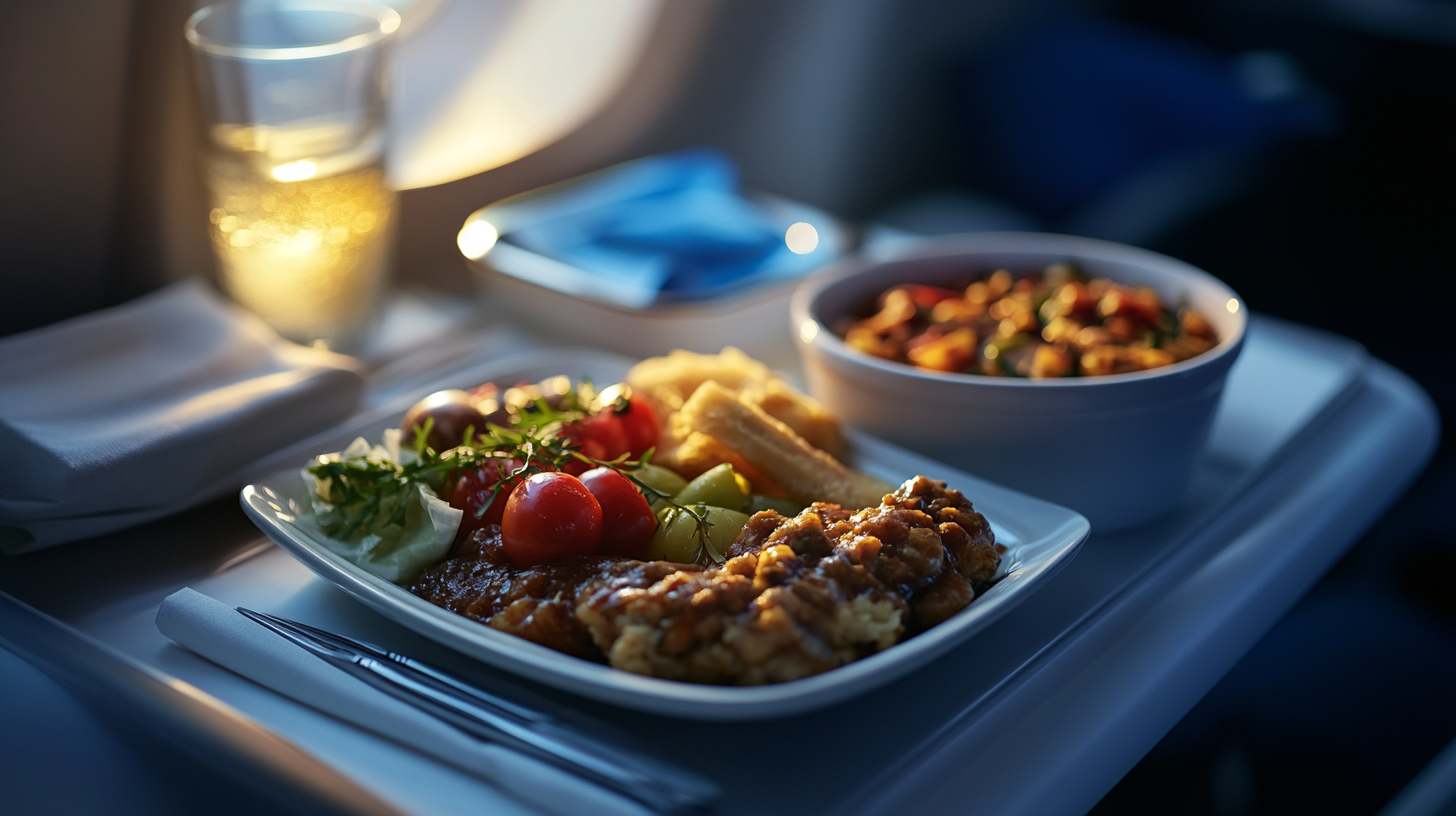
Kuwait Airways has garnered acclaim for its exceptional in-flight meals, topping a ranking by MoneySuperMarket for best airline food. Passengers commend the airline for providing high-quality dining across all classes, with menus that feature Middle Eastern delicacies such as lamb machboos and falafel wraps. The airline’s emphasis on flavorful, well-prepared dishes reflects a broader commitment among Middle Eastern carriers to offer superior service and culinary excellence. This dedication enhances passenger satisfaction and positions Kuwait Airways prominently in the competitive aviation market, a strategy explored in The Rise of Middle Eastern Airlines in Global Aviation .
Noteworthy Passenger Reviews
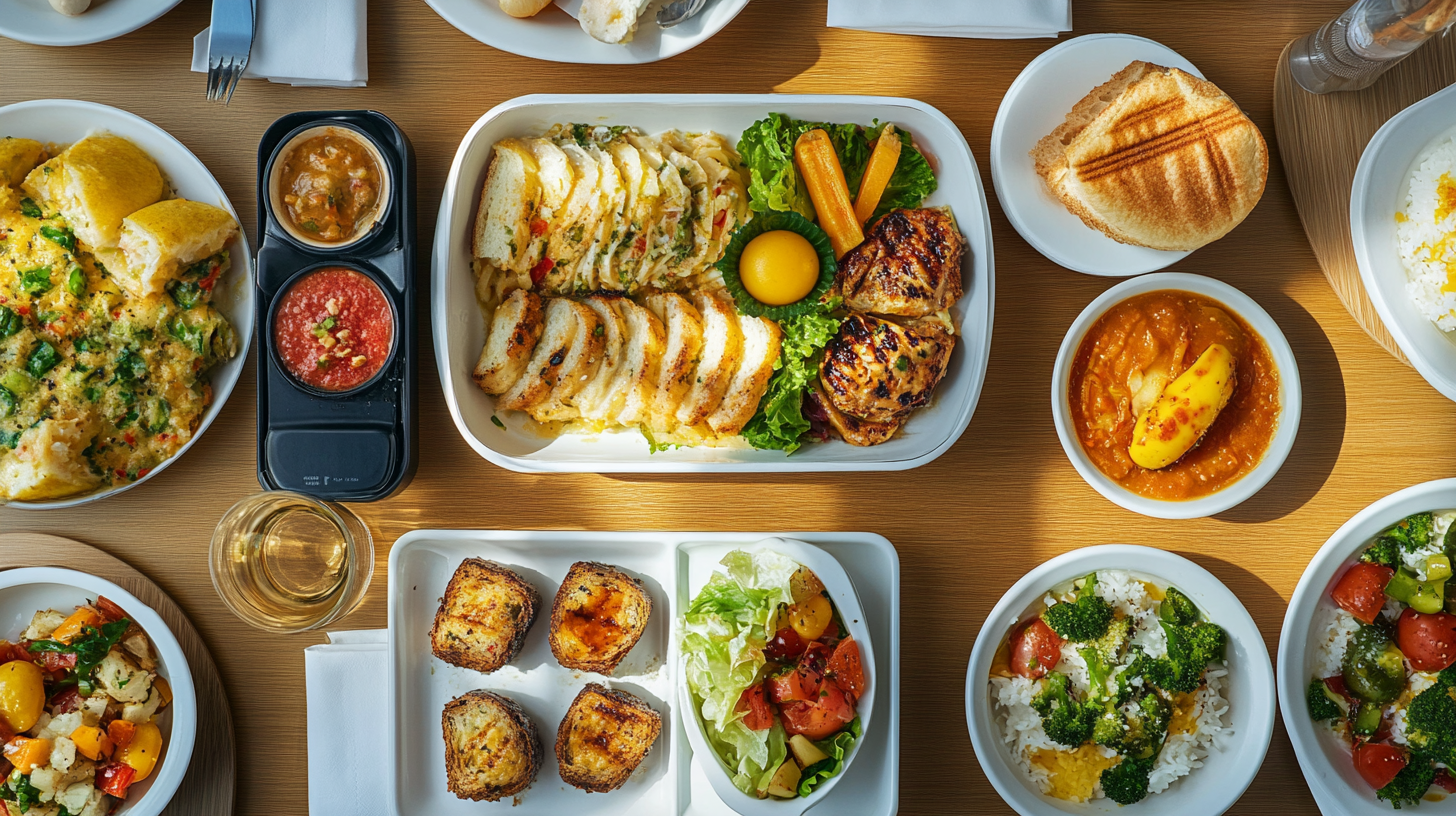
Passenger experiences with airline meals can vary widely, with some airlines earning high praise and others facing criticism. Personal accounts highlight the impact of in-flight dining on overall satisfaction.
Positive Experiences
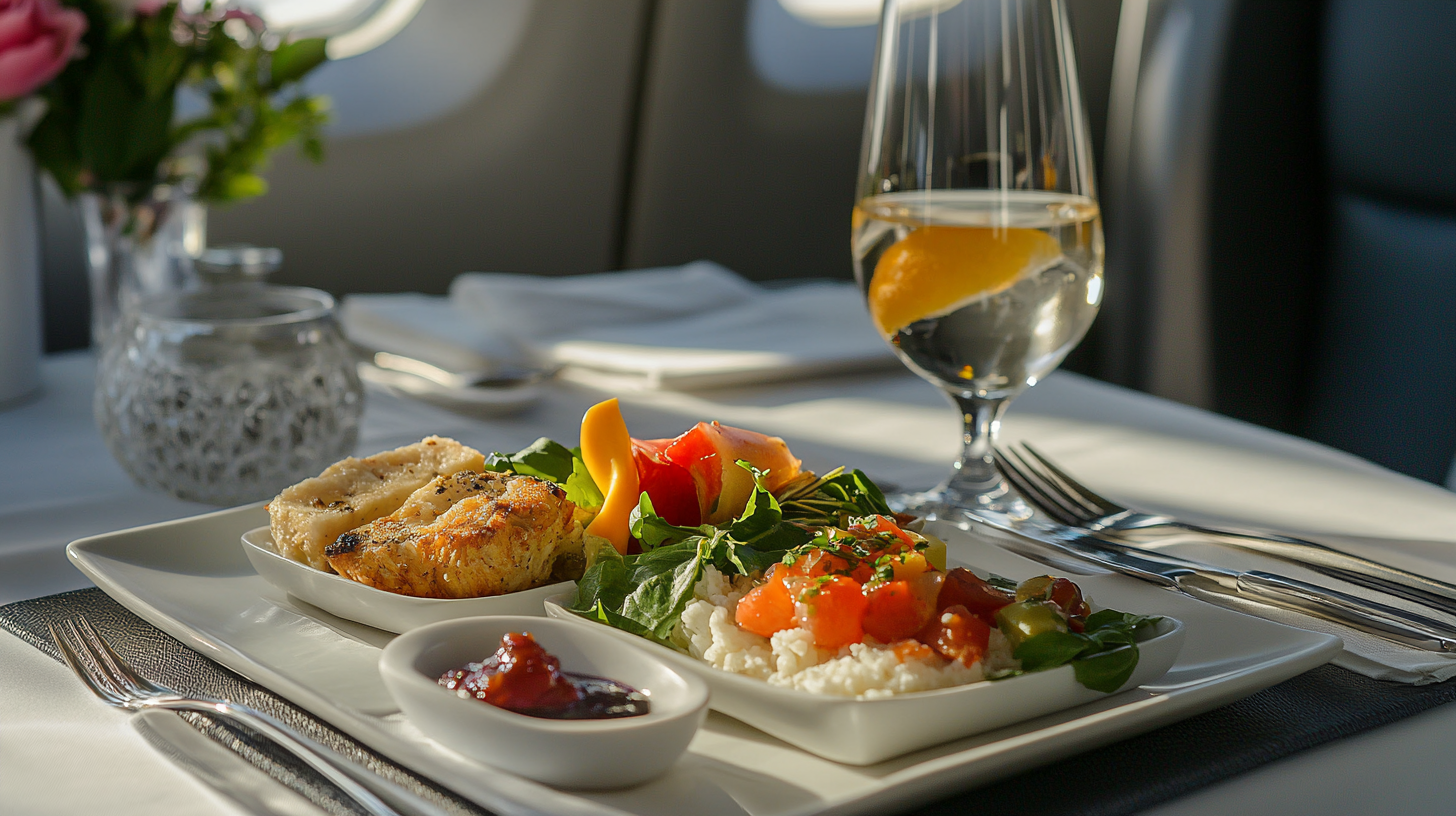
- Celine Linarte on Delta First Class: Rated her meal 6.5/10, appreciating the cornbread and carrot cake. She noted the comfort of the dining experience and the attentiveness of the cabin crew.
- Rick Lox on JetBlue Mint: Gave a 7.1/10 for the lamb shoulder, finding the meal decent overall. He was impressed with the presentation and freshness of the ingredients.
- Jasmine Pak on China Airlines Premium Economy: Awarded a perfect 10/10 for dishes like chicken and steak, highlighting the exceptional quality and flavor, which exceeded her expectations for premium economy fare.
- British Airways Economy: Passengers enjoyed meals like olive and mushroom pasta and appreciated complimentary drinks on the SFO to LHR route, noting the generous portions and inclusion of dessert.
Negative Experiences

- ITA Airways: Faced criticism for subpar vegan meal options, disappointing travelers expecting gourmet Italian cuisine. Passengers found the offerings bland and lacking variety.
- United Airlines: Disappointed with limited options and poor quality on a Papeete to San Francisco flight. Feedback pointed to overcooked meals and a lack of fresh ingredients.
- Miranda Shaffer on Air France Economy: Found the food disappointing, scoring it just 3/10. She cited a lack of flavor and unsatisfactory presentation.
- HungryPursuit on Air Canada Economy: Gave a 4/10, critiquing the beef stew for being too salty and lacking in substance.
Economy Class Surprises
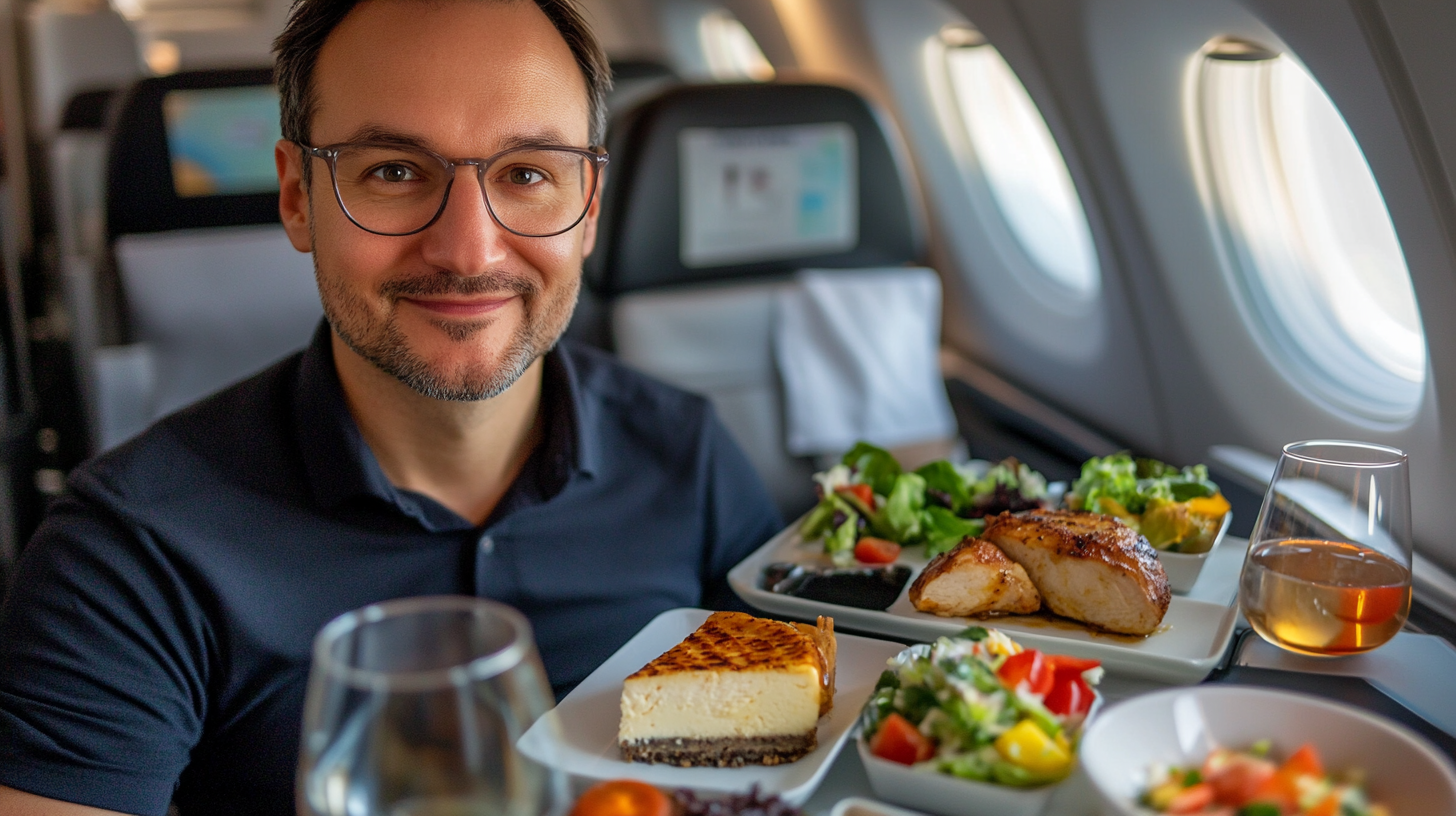
While premium classes often boast superior dining experiences, economy class can sometimes pleasantly surprise passengers with high-quality meals that rival those of higher classes. These unexpected delights enhance the perceived value of the flight.
- El Al: Offered notable hummus and meatballs on the JFK to TLV flight. Passengers praised the authentic flavors and generous portions that provided a comforting taste of home.
- South African Airways: Impressed with a delicious frittata on the IAD to ACC route. The freshness and seasoning of the meal stood out, earning positive reviews from travelers.
- Virgin Atlantic and Delta: Earned praise for flavorful meals, well-designed menus, and quality snacks, rounding out the top five economy class experiences. Passengers highlighted the consistent quality and variety offered throughout the flight.
The Inconsistency of Airline Meals
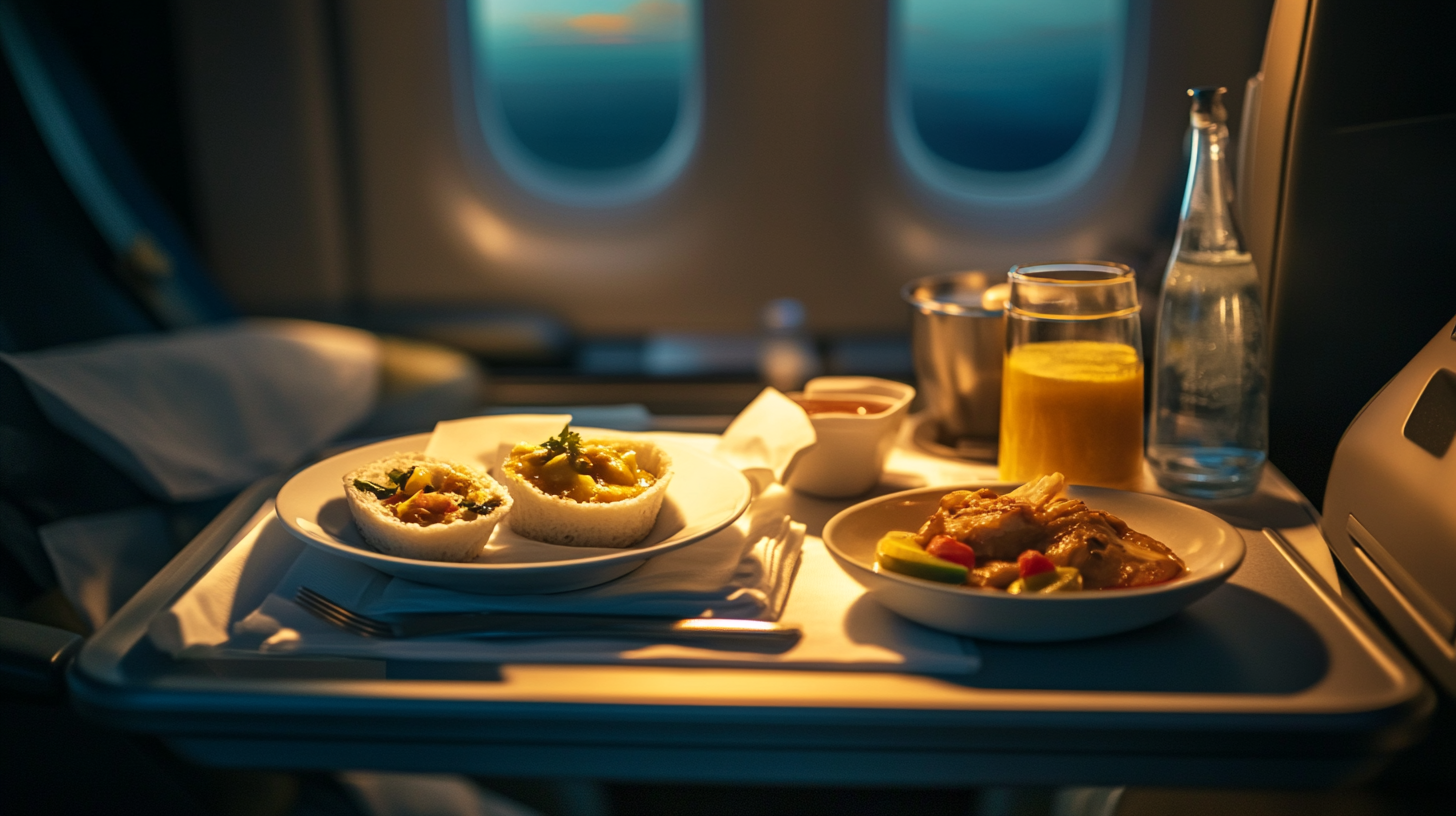
Airline meal quality can vary significantly between classes, airlines, and even individual flights. Factors contributing to this inconsistency include cost-cutting measures, which may lead to simplified menus or lower-quality ingredients, and supply chain challenges that affect the availability of fresh produce. The inherent difficulties of serving food at altitude, such as taste alteration and limited preparation facilities, further complicate consistency. Some business class meals may disappoint with bland or unappealing offerings despite the premium price, while economy class passengers might be pleasantly surprised by meals that exceed expectations. This unpredictability highlights the importance of airlines maintaining high standards across all classes to ensure passenger satisfaction, as analyzed in The Impact of Cost Management on In-Flight Catering Quality .
Tips for Passengers
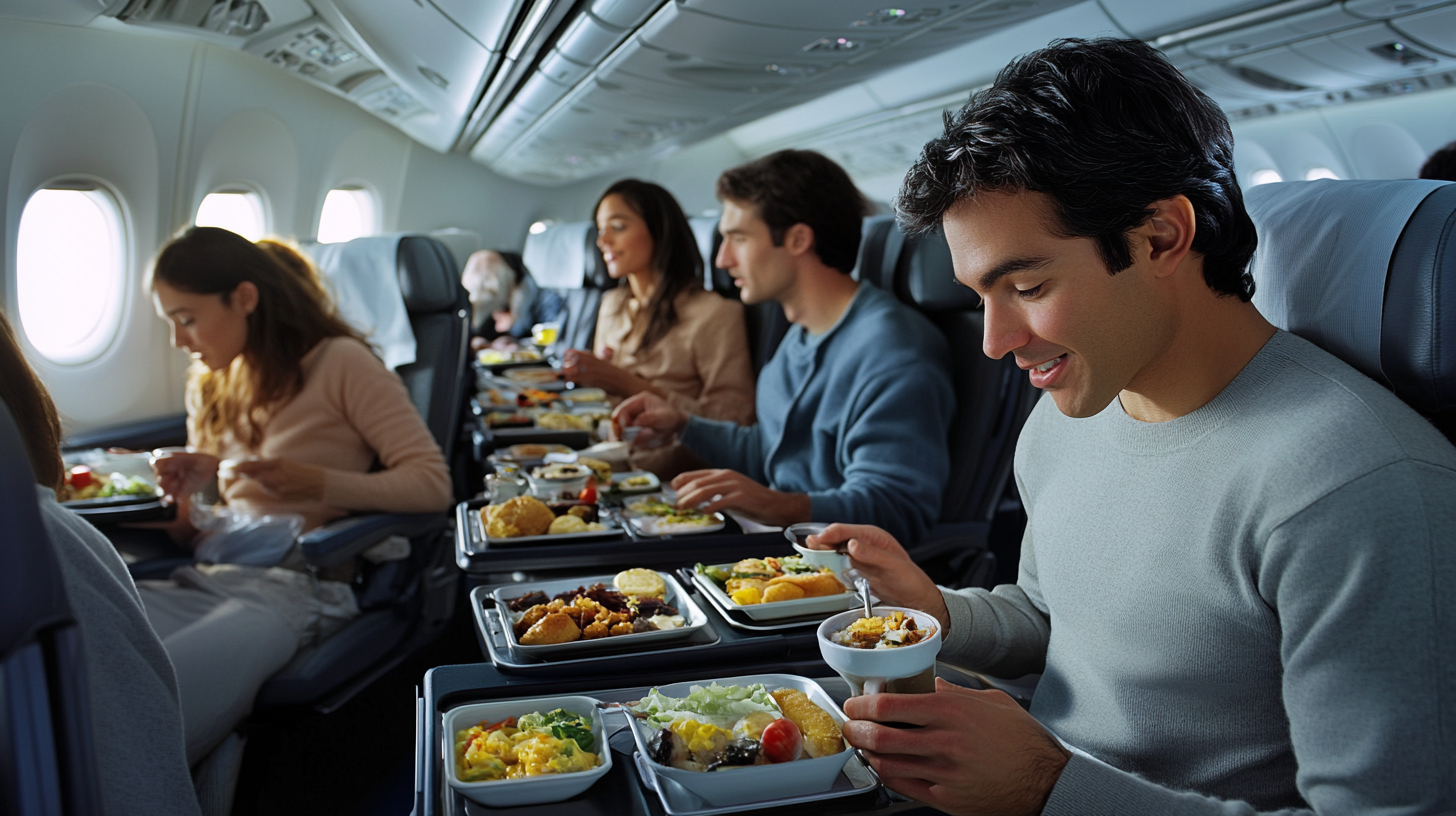
Given the variability of in-flight meals, passengers can take proactive steps to enhance their dining experience during flights:
- Opt for Bold Flavors: Choose dishes with robust sauces or spices, such as curries or stews, which tend to retain their taste better in the cabin environment where taste sensitivity is reduced.
- Pre-Order Special Meals: Airlines often accommodate special dietary needs, including vegetarian, vegan, kosher, or halal meals. Pre-ordering can ensure a meal that suits your preferences and may be prepared with more care.
- Bring Your Own Snacks: For flights without meal service or to supplement the offerings, bringing personal snacks can provide comfort. Items like nuts, granola bars, or dried fruit are convenient and acceptable through security checkpoints.
The Future of In-Flight Dining

As airlines continue to navigate the complexities of in-flight dining, many are investing in innovation and actively seeking customer feedback to improve meal quality. Collaborations with renowned chefs and culinary institutes are expected to become more widespread, bringing expertise and creativity to airline menus. The focus on fresh, regional ingredients aligns with global trends toward sustainable and locally sourced food. Customization options are likely to expand, with technology enabling greater personalization of meals, possibly even allowing passengers to tailor ingredients and portion sizes. Airlines that prioritize the in-flight dining experience can anticipate enhanced passenger satisfaction, positive reviews, and increased loyalty, as future travelers select carriers not just for their destinations but for the holistic experience offered, as predicted in Future Trends in Airline Passenger Experience .
Final Thoughts
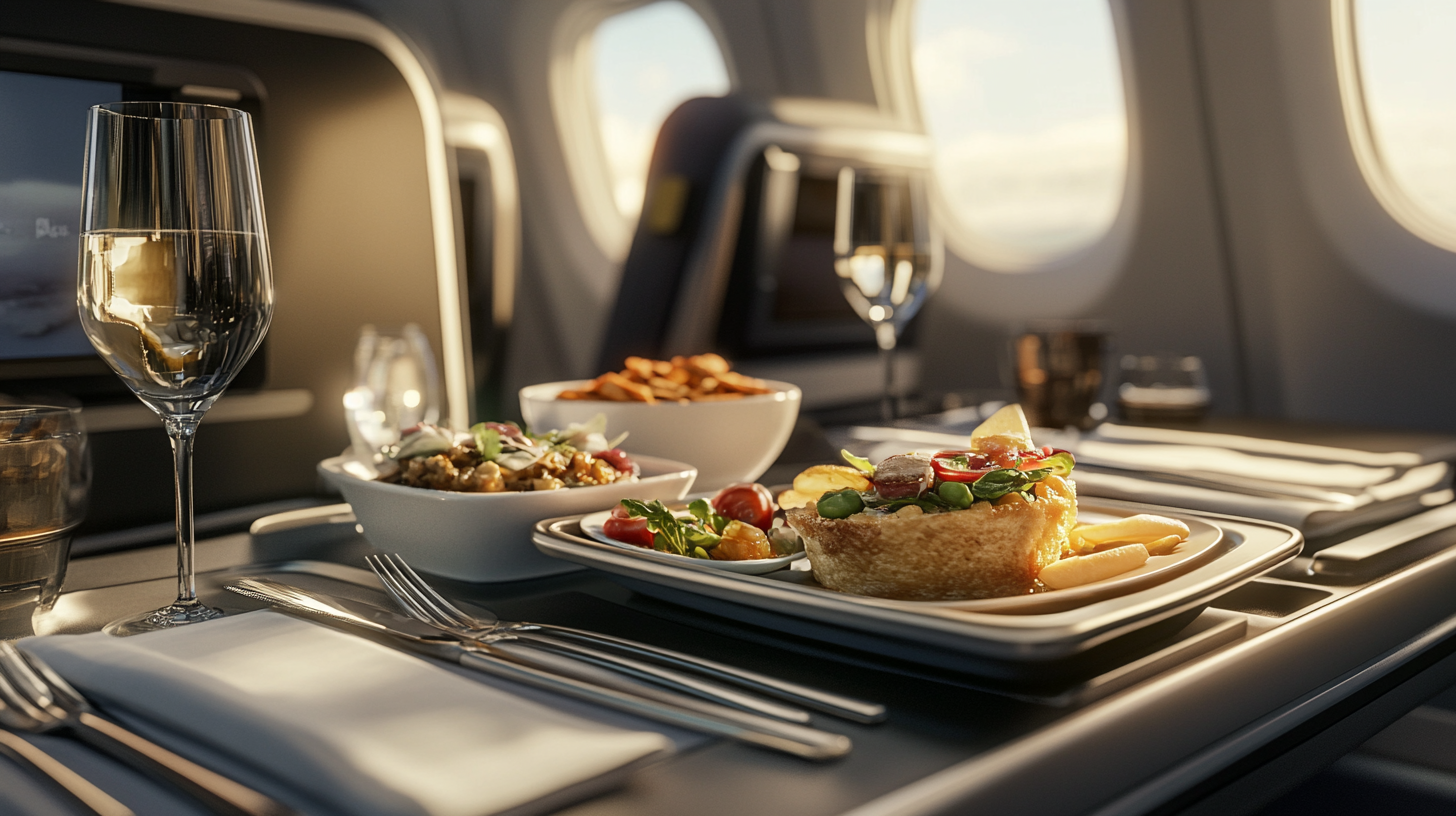
Airline food remains a topic of spirited discussion among travelers, reflecting its significance in the overall flying experience. The best airlines understand that high-quality meals are not merely a convenience but a critical component of customer satisfaction and brand differentiation. By addressing the challenges unique to in-flight dining and embracing innovative solutions, airlines can transform meals into memorable highlights of air travel.
Share Your Experience
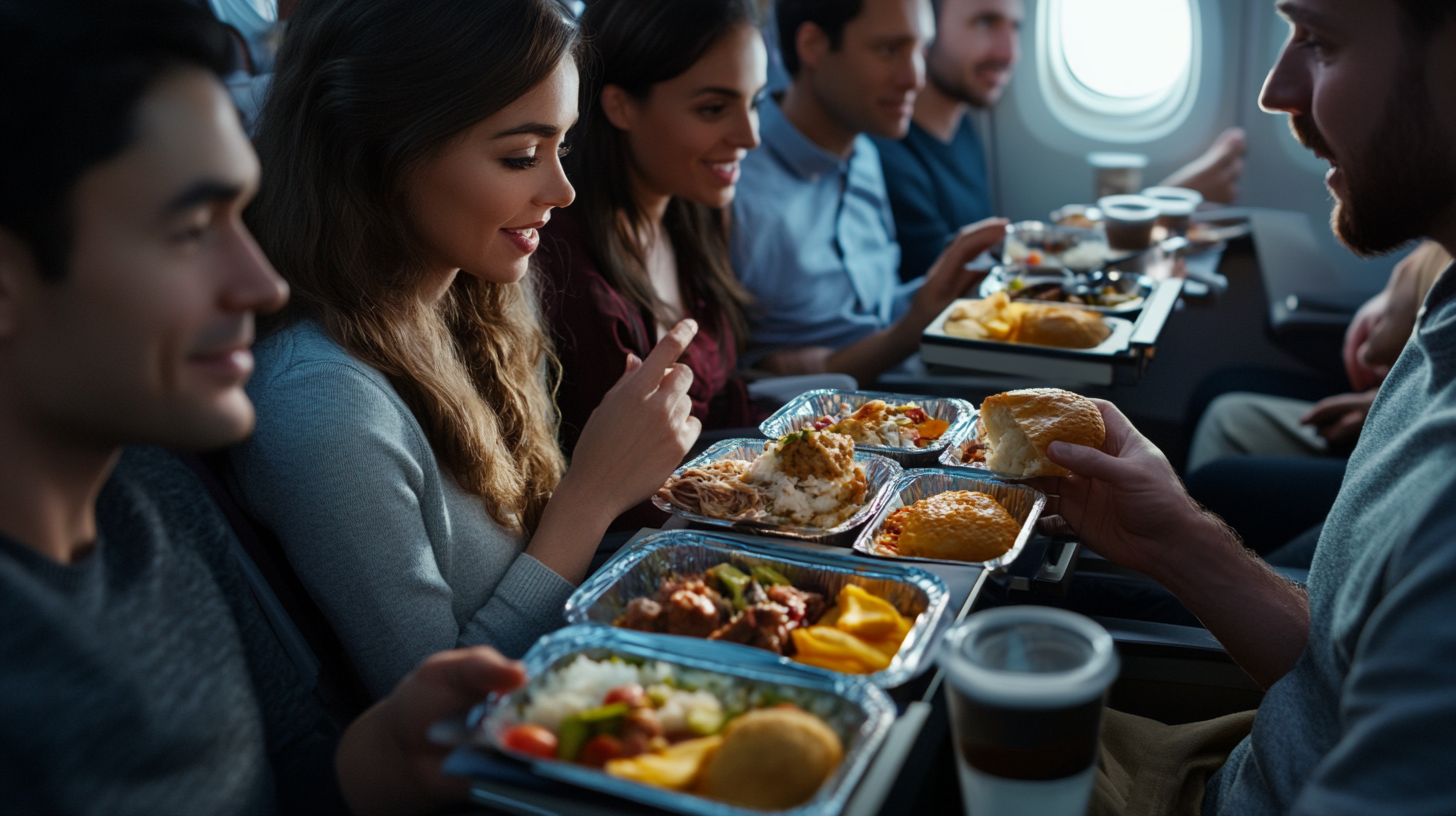
Have you had a memorable in-flight meal that delighted your senses or a dining experience that fell short of expectations? Share your stories and insights in the comments below. Your experiences can help fellow travelers make informed choices and contribute to the ongoing conversation about the evolution of airline food.
Follow us back to Seat 5A for more insights and updates on the world of aviation and travel.




